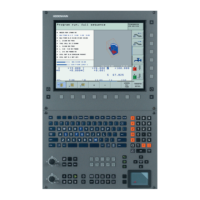HEIDENHAIN iTNC 530 315
10.4 Miscellaneous Functions for Contouring Behavior
Calculating the radius-compensated path in
advance (LOOK AHEAD): M120
Standard behavior
If the tool radius is larger than the contour step that is to be machined
with radius compensation, the TNC interrupts program run and
generates an error message. M97 (see “Machining small contour
steps: M97” on page 309) inhibits the error message, but this results
in dwell marks and will also move the corner.
If the programmed contour contains undercut features, the tool may
damage the contour.
Behavior with M120
The TNC checks radius-compensated paths for contour undercuts and
tool path intersections, and calculates the tool path in advance from
the current block. Areas of the contour that might be damaged by the
tool are not machined (dark areas in figure). You can also use M120 to
calculate the radius compensation for digitized data or data created on
an external programming system. This means that deviations from the
theoretical tool radius can be compensated.
Use LA (Look Ahead) after M120 to define the number of blocks
(maximum: 99) that you want the TNC to calculate in advance. Note
that the larger the number of blocks you choose, the higher the block
processing time will be.
Input
If you enter M120 in a positioning block, the TNC continues the dialog
for this block by asking you the number of blocks LA that are to be
calculated in advance.
Effect
M120 must be located in an NC block that also contains radius
compensation G41 or G42. M120 is then effective from this block until
radius compensation is canceled with G40
M120 LA0 is programmed, or
M120 is programmed without LA, or
another program is called with %
the working plane is tilted with Cycle G80 or the PLANE function
M120 becomes effective at the start of block.

